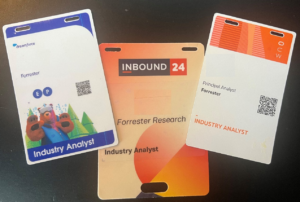My Take On The Year Ahead For Sales Tech After Attending Three Key Events
Unsurprisingly, AI was at the center of all discussions during three key technology provider events I attended over the past few weeks, with AI agents being the most prominent buzz as the next evolution of AI. Going a layer deeper, however, reveals a more nuanced strategy for each host vendor. These companies are well established and their leaders are smart, with a thorough understanding of their company’s core competencies that allow them to message and deliver product updates aligned to their strengths. Here are one analyst’s takeaways from the events.
Dreamforce
The prominent message of this event was that Salesforce has an AI agent you can build quickly to replace tedious manual human tasks and that now is the best time to start building. Salesforce leaders indicated that, while agents are available today to help organizations automate human tasks, companies should go a step further and release them autonomously into customer workflows.
Key points:
- Pricing for AI: Consumption fees will apply. Standard contracts will likely include a certain number of prepaid credits initially and move to a consumption-based model following the onset.
- What I loved: As usual, Salesforce delivered an inspiring vision that allowed its customers to truly see the value it can provide, aggressively encouraging users to build and implement agents quickly. This push will drive significant interest in the market, which will propel sales tech innovation forward.
- What I’m skeptical about: While inspirational, the position makes a lot of assumptions about data quality and the ease with which agents can handle the unpredictable nature of human conversations.
INBOUND
While HubSpot has pushed the edges of where AI agents are today, its announcements at INBOUND centered on helping customers deploy purpose-built agents to make the seller’s job easier, with a focus on small businesses, which is aligned to its customer base. HubSpot also demonstrated how it is using the Clearbit acquisition to enable higher-quality inbound account and contact enrichment.
Key points:
- Pricing for AI: included in software license. AI will be embedded as part of the product and therefore will not be a separate charge.
- What I loved: The features were forward-looking but practical. HubSpot has invested in a data-first approach, ensuring that its platform data remains unified and adding additional enrichment through Clearbit. This focus will enable its customers to benefit from AI faster.
- What I’m skeptical about: The platform leans heavily toward marketing, which is concerning for sales users. While Sales Hub developers made solid value-add additions, the company needs to support its continued evolution for it to keep up with its marketing capabilities.
CloudWorld
Oracle had a different approach because of the breadth of its back-office capabilities. While Oracle has announced plenty of AI agents that can be deployed across its platform, its focus was on deploying AI across the full platform instead. The vision expressed was to use AI to bring the value of back-office data to the front office. For sales, there was a specific emphasis on the value of AI to optimize quoting and late-stage deal performance.
Key points:
- Pricing for AI: included in software license. AI will be embedded in Oracle’s applications, avoiding consolidating AI into an AI-specific app.
- What I loved: While AI is changing everything, Oracle is staying focused on using this new technology to amplify its strengths in the back office.
- What I’m skeptical about: Building valuable connections across platforms provides value for those with more Oracle platforms but will be less impactful for those with a limited Oracle tech stack.
While each of these events blurred the lines around what was available today versus what was planned for the future, each company had its own unique strategy on how it will put AI at the center of its roadmaps. AI agents are the new hot topic, and each vendor has its own unique definition and purpose for them. As such, customers should avoid using the term “AI” interchangeably with vendors. Instead, evaluate each vendor’s offerings to determine where they could add value to your organization.

